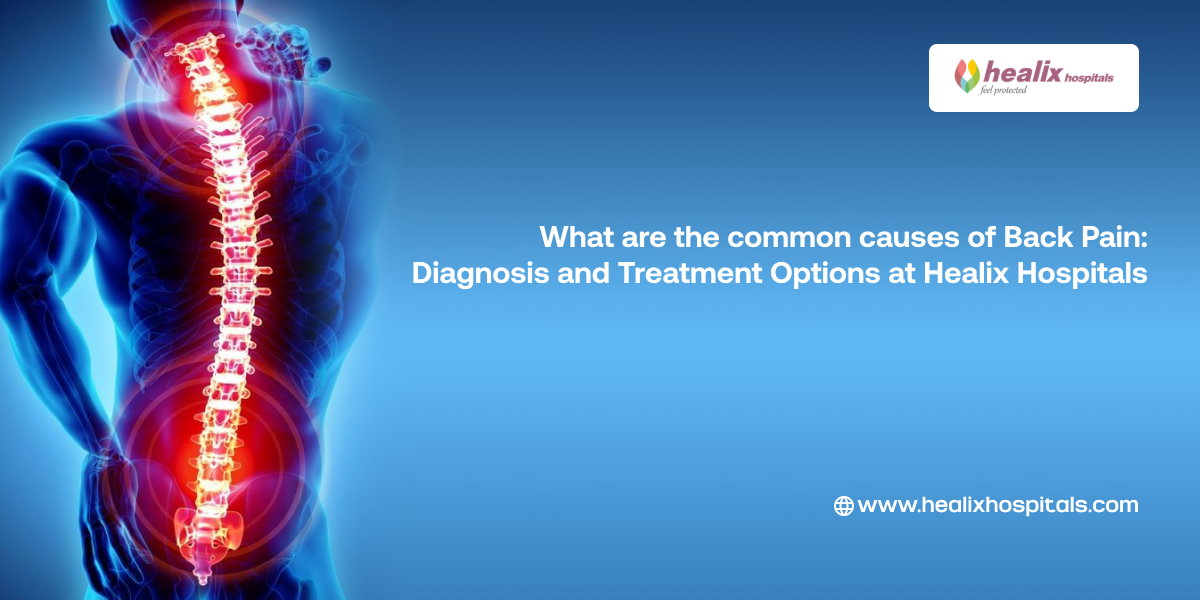What Are the Common Causes of Back Pain: Diagnosis and Treatment Options at Healix Hospitals

Back pain is a significant health concern affecting millions worldwide. Understanding the causes of back pain is crucial for effective diagnosis and treatment. At Healix Hospitals, we are dedicated to identifying the root causes and providing comprehensive treatment options. This blog will delve into the causes of back pain, how we diagnose these issues, and the various treatment methods available.
Understanding the Common Causes of Back Pain
Causes of back pain can be diverse, ranging from muscle strains to complex spinal conditions. Here’s an overview of some common causes of back pain:
- Muscle Strains and Ligament Sprains: Overuse or improper use of back muscles often leads to strains or sprains. These can be caused by lifting heavy objects, sudden movements, or poor posture.
- Herniated Discs: A herniated disc occurs when the inner gel-like substance of a spinal disc protrudes and irritates nearby nerves, causing significant pain.
- Degenerative Disc Disease: Aging can lead to the deterioration of spinal discs, causing pain and stiffness in the back.
- Spinal Stenosis: Narrowing of the spinal canal can compress the spinal cord and nerves, leading to pain, numbness, and weakness.
- Osteoarthritis: This condition involves the breakdown of cartilage in the spine, leading to pain and stiffness.
- Scoliosis: An abnormal curvature of the spine, known as scoliosis, can cause discomfort and pain.
- Kidney Stones or Infections: Sometimes, issues such as kidney stones or urinary tract infections can cause referred back pain.
- Infections and Tumors: Though less common, infections or tumors in the spine can lead to severe back pain.

Diagnosing the Causes of Back Pain
Accurate back pain diagnosis is essential for effective treatment. At Healix Hospitals, we utilize various methods to diagnose the underlying causes of back pain:
- Medical History Review: A thorough review of your medical history helps identify potential causes of back pain, including previous injuries or health conditions.
- Physical Examination: Assessing your posture, flexibility, and range of motion helps pinpoint areas of pain and discomfort.
- Imaging Tests: We may use X-rays, MRIs, or CT scans to visualize the spine and detect issues like herniated discs or fractures. These imaging tests are crucial for accurate back pain diagnosis.
- Laboratory Tests: Blood tests or urinalysis may be conducted to rule out infections or other conditions contributing to back pain.
- Specialist Consultations: For complex cases, consultations with specialists such as orthopedic surgeons or neurologists may be necessary to obtain a comprehensive diagnosis.

Treatment Options for Back Pain
Once the causes of back pain are identified, various treatment options are available to manage and alleviate symptoms. These treatments can be categorized into non-surgical and surgical methods.
Non-Surgical Back Pain Treatments
- Physical Therapy: Essential for back pain management, physical therapy involves exercises to strengthen back muscles, improve flexibility, and promote proper posture.
- Medications: Over-the-counter pain relievers like ibuprofen or acetaminophen can provide temporary relief. For severe pain, prescription medications may be prescribed.
- Heat and Cold Therapy: Applying heat or cold packs to the affected area helps reduce inflammation and alleviate pain. These methods are effective back pain relief methods.
- Lifestyle Modifications: Adjustments in daily activities, such as improving posture and avoiding activities that strain the back, are important for preventing further issues. These are critical back pain management strategies.
- Alternative Therapies: Techniques like acupuncture, massage therapy, and chiropractic care may provide additional relief for some patients. These back pain relief options can complement other treatments.
- Injections: For persistent pain, spinal injections such as epidural steroid injections can reduce inflammation and provide temporary relief.
Surgical Back Pain Treatments
In cases where non-surgical treatments are ineffective, surgical options may be considered:
- Discectomy: This procedure involves removing a portion of a herniated disc pressing on a nerve root. It addresses severe spine-related back pain.
- Laminectomy: A surgical procedure that involves removing a part of the vertebrae to relieve pressure on the spinal cord or nerves.
- Spinal Fusion: This surgery joins two or more vertebrae to stabilize the spine and reduce pain.
- Artificial Disc Replacement: Involves removing a damaged disc and replacing it with an artificial one. This option is considered for severe cases of back pain relief methods.

Chronic Back Pain Causes and Management
Chronic back pain causes can include long-term conditions such as degenerative disc disease, osteoarthritis, or spinal stenosis. Managing chronic pain often involves:
- Ongoing Physical Therapy: Regular physical therapy helps maintain strength and flexibility, preventing recurrence of pain.
- Pain Management Programs: Comprehensive programs may include medications, injections, and alternative therapies for effective back pain management.
- Supportive Devices: Braces or orthotics can provide stability and alleviate pain.
- Surgical Interventions: In some cases, surgical options may be necessary to address the root cause of chronic pain.
Back Pain Relief Methods and Options
Effective back pain relief methods are essential for improving quality of life. Some back pain relief options include:
- Regular Exercise: Engaging in low-impact exercises like swimming or walking helps strengthen the back and reduce pain.
-
Comments